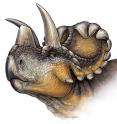Horned dinosaur discovery sheds light on nose horn evolution in Triceratops family
Scientists have discovered Wendiceratops pinhornensis, a new species of horned dinosaur based on fossils collected from a bone bed in southern Alberta, Canada, according to a study published July 8, 2015 in the open-access journal PLOS ONE by co-authors David Evans from the Royal Ontario Museum and Michael Ryan from Cleveland Museum of Natural History. The new dinosaur, named Wendiceratops pinhornensis, is described from over 200 bones representing the remains of at least four individuals, three adults and one juvenile, collected from a bonebed in southern Alberta, Canada. Wendiceratops pinhornensis was approximately 20 feet long and weighed more than a ton. It lived about 79 million years ago, making it one of the oldest known members of the family of large-bodied horned dinosaurs that includes the famous Triceratops, the Ceratopsidae.
A series of forward-curling hook-like horns adorn the margin of the wide, shield-like frill that projects from the back of the Wendiceratop skull, considered elaborate by the authors for an early member of the horned dinosaur family. The nasal bone, although represented by fragmentary specimens, likely supported a prominent, upright nasal horn. This may represent the earliest documented occurrence of a tall nose horn in Ceratopsia, possibly shedding light on nose horn evolution in the horned dinosaur family. The addition of Wendiceratops adds to a growing body of research which suggests high diversity of ceratopsids likely associated with a rapid evolutionary radiation in the group.
"Wendiceratops helps us understand the early evolution of skull ornamentation in an iconic group of dinosaurs characterized by their horned faces." said co-author Dr. David Evans. "The wide frill of Wendiceratops is ringed by numerous curled horns, the nose had a large, upright horn, and it's likely there were horns over the eyes too. The number of gnarly frill projections and horns makes it one of the most striking horned dinosaurs ever found."
The name Wendiceratops means "Wendy's horned-face", and celebrates renowned Alberta fossil hunter Wendy Sloboda, who discovered the site in 2010.
Source: PLOS
Articles on the same topic
- New horned dinosaur reveals evolution of nose horn in Triceratops familyWed, 8 Jul 2015, 20:04:32 UTC
Other sources
- New horned dinosaur reveals evolution of nose horn in Triceratops familyfrom PhysorgThu, 9 Jul 2015, 7:00:49 UTC
- Meet Wendiceratops, a horned dinosaur unlike any otherfrom LA Times - ScienceThu, 9 Jul 2015, 0:30:19 UTC
- Wendiceratops dino had "extravagant" halo of hornsfrom CBSNews - ScienceWed, 8 Jul 2015, 22:10:06 UTC
- New horned dinosaur reveals evolution of nose horn in Triceratops familyfrom Science DailyWed, 8 Jul 2015, 20:00:29 UTC
- How dinos like Triceratops got their hornsfrom Sciencenews.orgWed, 8 Jul 2015, 19:50:07 UTC
- 'Wendy' Adds a Hook to the Tale of Horned Dinosaursfrom MSNBC: ScienceWed, 8 Jul 2015, 19:00:08 UTC
- Photos: New Triceratops Cousin Unearthedfrom Live ScienceWed, 8 Jul 2015, 18:30:38 UTC
- Frills and Whistles: Triceratops Relative Had Bizarre Head of Hornsfrom Live ScienceWed, 8 Jul 2015, 18:30:37 UTC
- New horned dinosaur reveals evolution of nose horn in Triceratops familyfrom PhysorgWed, 8 Jul 2015, 18:30:21 UTC
- New Triceratops Relative Discovered, Named ‘Wendy’from PopSciWed, 8 Jul 2015, 18:30:17 UTC
- Striking new dinosaur honours legendary Alberta fossil hunterfrom CBC: Technology & ScienceWed, 8 Jul 2015, 18:30:07 UTC
